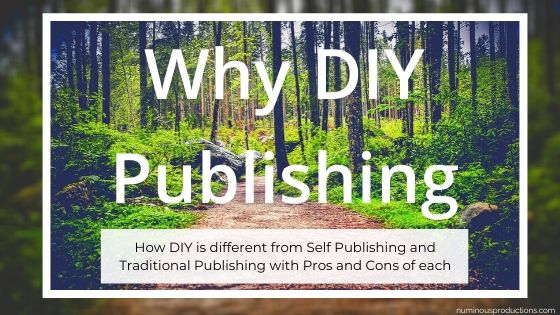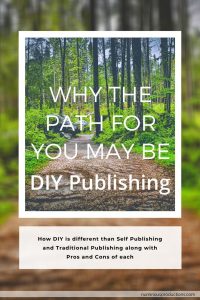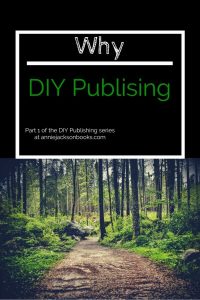I used to think there were only 2 paths to publication: “Self” Publishing and Traditional Publishing. Then I was looking for some references online for Enchanted Storms and googled “self publishing” and discovered it’s not always defined the way I meant it. Turns out, there’s actually 3 paths to publication: Traditional Publishing, “Self” Publishing and DIY Publishing.
Why the distinction between “Self” Publishing and DIY Publishing?
You may have noticed I keep putting “Self” publishing in quotes. When I used that term in the past I just meant you were the author of your own destiny. You were the publisher and from start to finish and every step in between, you made it happen.
But when you do a search for “self publishing” you get a lot of small presses that will charge you anywhere from $399-$1,399 to publish your book. So I’ve commandeered the term “Self” publishing to mean ‘I’m doing it myself by letting someone else help me.’ And there’s nothing wrong with that. Paying someone to do the things you’re not as skilled in while you focus on where you are talented is actually good advice.
DIY Publishing is for when you actually want to do everything yourself.
The cool thing is, you can mix and match. Beyond small presses, there’s a lot of talented people who do one piece of the publishing puzzle or another. You can DIY on some parts and hire out other parts.
So, this is the first in my DIY Publishing series. Gathered from years of learning skills at different jobs, avoiding boredom at other jobs, plenty of research, and practiced by publishing my first two novels, I’ll show you all the pieces of DIY publishing (with tips and advice learned along the way) so you can decide where you want to DIY and where you can leverage someone else’s skills.
Lesson the first, the benefits and costs of different publishing methods.
Both “Self” Publishing and DIY Publishing fall under the umbrella of Indie Publishing, which is really anything that isn’t Traditional. And they share several pros and cons.
Indie Publishing
Benefits
- Control – when you’re the publisher, you get to make all the decisions.
This could just as easily end up in the Costs section because sometimes the weight of decisions is stressful. How do you know if that cover will attract readers? Or whether to join KDP Select? Or if this editor is good to work with?But you do know what you like and what you don’t like. You know what fits your story and what doesn’t; what will make you happy as an author. You get to keep the things you love. You get to find the pieces that best fit your story. And you get to release your book to the world your way. - Timing – There’s a lot of work that goes into Indie Publishing but once it’s all done, it takes less than 48 hours for your book to be available to the world.Your book, your timing, your strategy for release and then readers can find it and you’re onto your next novel.
- Money – The more middlemen you remove, the more of the profits you get to keep. Distributing your work yourself means you get higher percentages of every book sale.
Costs
- Visibility – with no agent, no editor, no publishing house with a vested interest in your success, if you want to get noticed then you need to do it yourself. Thousands of books are published every day, millions of people with twitter accounts and pinterest accounts and blogs. If you’re going to stand out, it’s up to you.
- Legitimacy – Everything I list below in the traditional publishing section? You have none of it when you Indie Publish. There are some awards you can apply for. And the book community is very inclusive, which is awesome. But there’s a line and you’re either on one side or the other (hybrid authors straddle the line).
- Money – like what I did there? More effort to gain visibility generally means fewer book sales. Obviously, this is not always true. There are amazon bestsellers and people who live very comfortably on the money from indie publishing – so it’s not always a Con. But it’s on this side because even if you are making a lot of money in indie publishing, you’re probably also working a lot harder for it.
The differences between DIY and “Self” publishing really come down to two things. Time and Money.
“Self” Publishing
- Someone else does the work for you. And it’s not just the effort of doing the work, doing good work takes time. Letting someone else put in the time to do the publishing part of your book means you get to do more of the writing part of other books.
- For which you pay them. Sometimes it’s a lot of money, sometimes it’s less. Maybe you have the money, maybe parting with $400 isn’t so easy. There’s a whole scale in which this is a good idea and a bad idea in varying degrees but wherever you end up on that scale, it’s going to cost you.
- Also, paying someone to do the work for you is no guarantee they’ll do it well. Or that they are ethical. I would highly recommend doing your research and making sure the company (or person) you choose to pay for the work is worth what you’re paying.
DIY Publishing
- Doing everything yourself means you learn to do everything. This is why I originally wanted to pursue DIY Publishing. I wanted to know how you format an e-book and what it takes to sell it through the different channels. I wanted to understand every piece of the process and if you’re a kinetic learner like me, then this is how you do it.
- And while it doesn’t cost much money (it’s possible to publish your first book for about $100 – the second one for nothing out of pocket) your paying in time.
- You have to do everything yourself. Days to design a cover. Write a synopsis. Format different versions of your book. Some take more time than others but if you’re a DIY publisher, you’re not just an author. You’re a publisher and that will cost you time.
The other side of all this is to have someone else do everything for you and pay you for it. Sounds spectacular, doesn’t it. And yet, it comes with it’s own downside.
Traditional Publishing
Benefits
- Visibility – the publisher wants to recoup their investment in you so they spend some amount of money on marketing (everyone will tell you some is an extremely variable term). Book tours, ads, social media, giveaways for blog tours, there’s all sorts of ways for the publisher to promote your book.
- Distribution Channels – traditional publishers will get your book in book stores. Possibly in more libraries than just your local. Other channels (audiobook, film, tv) all depend on your contract (really to be fair, most of the this whole bullet point depends on your contract). There’s lots of places a traditional publisher can take your book depending on how well it’s done and how much money they decide to put into it.
- Legitimacy – again, there’s a lot of inclusion in the publishing world from readers and bloggers and authors. But there’s nothing like having an agent, having worked with an editor (the bigger the publishing house the better), seeing your book on the shelves of a bookstore to say, “I have arrived!” Not only that, a lot of the bestseller lists and awards only consider traditionally published titles so if you want the acclaim, this is the path to pursue it.
- Money – with more visibility and getting to leverage the resources of your publisher and the legitimacy of traditional publishing, you can sell a lot more books and make more money. You can also get advances so you can have money before you’ve actually finished a book. Which is not to say you don’t have to wait months to get paid. Or that the money you make will be a lot or even enough to live on. There’s a wide variety of experiences between bestsellers and midlist writers and unsuccessful authors that sway how much of a benefit this actually is.(And I highly recommend reading Kristine Kathryn Rusch, especially her information on contracts and deal breakers.)
Costs
- Time – Publishing houses have seasonal schedules to release books and they plan ahead. Far ahead. Most books, once they’re sold, take a year at minimum to be released.
- Control – Creative control, whether it’s the narrative or the title or the cover. Control over distribution, depending on the contract you sign. Control over the timing (see previous bullet point).
This isn’t meant to imply that traditional publishers are unreasonable or that because you sell control you will undoubtedly have a negative experience. Lots of authors have great relationships with editors and publishers and have a voice in their work (whether it’s choosing a cover model or approving the title or releasing a novel that is genuinely the creative work they want it to be). Doesn’t change the fact that selling control means you no longer have it. - Money – you totally saw it coming this time, didn’t you? The downside of traditional publishing is you get a smaller percent of every sale. Because your publisher is a business and they need to cover their costs. And your agent does this for a living and works (one would hope) for their cut too.
Clearly, there’s a number of reasons to consider the different paths (and plenty more reasons to be a hybrid author). What do you think? Did I miss any relevant comparisons? Does DIY Publishing sound like an enticing path?
Want some info on how? Check out out a quick guide through the DIY Publishing process.
Or dive deeper into DIY Publishing with the first step – setting up important privacy measures.



